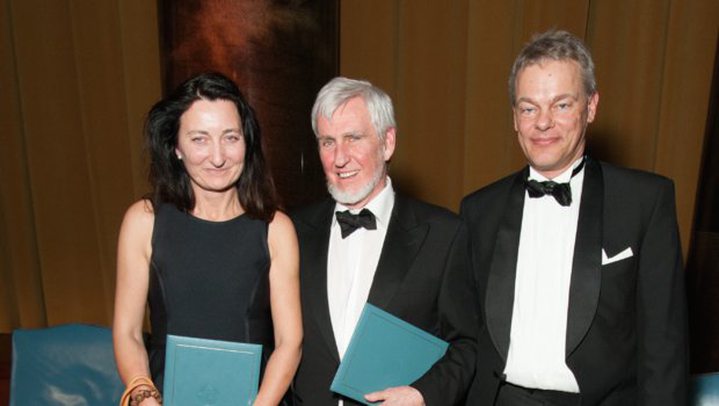Nobel Prize in Medicine Is Awarded to Three Who Discovered Brain’s ‘Inner GPS’

John O'Keefe (center), Edvard Moser (right) and and May-Britt Moser (left)
John O’Keefe, 75, a British-American scientist, will share the prize of $1.1 million with May-Britt Moser, 51, and Edvard I. Moser, 52, only the second married couple to win a Nobel in medicine, who will receive the other half.
The three scientists’ discoveries “have solved a problem that has occupied philosophers and scientists for centuries — how does the brain create a map of the space surrounding us and how can we navigate our way through a complex environment?” said the Karolinska Institute in Sweden, which chooses the laureates.
The positioning system they discovered helps us know where we are, find our way from place to place and store the information for the next time, said Goran K. Hansson, secretary of the Karolinska’s Nobel Committee.
The researchers documented that certain cells are responsible for the higher cognitive function that steers the navigational system.
Dr. O’Keefe began using neurophysiological methods in the late 1960s to study how the brain controls behavior and sense of direction. In 1971, he discovered the first component of the inner navigational system in rats. He identified nerve cells in the hippocampus region of the brain that were always activated when a rat was at a certain location.
He called them “place cells” and showed that the cells registered not only what they saw, but also what they did not see, by building inner maps in different environments.
Dr. O’Keefe was born in New York City to immigrant Irish parents and graduated from the City College of New York. In 1967, he earned a Ph.D. in physiological psychology at McGill University in Montreal, and then moved for postdoctoral training to University College London, where he is now a professor of cognitive neuroscience.
He told reporters that he was surprised to win a Nobel, Reuters reported, particularly after a “checkered” youth in which he studied the classics in school and aeronautics in college before venturing into philosophy and psychology.
Dr. Eric R. Kandel of Columbia University, who won a Nobel Prize for his research on the brain, said in an interview that before Dr. O’Keefe’s research, comparatively little was known about the hippocampus. “We knew it had something to do with memory,” he said, but not which hippocampal cells controlled which functions.
Dr. Kandel said he spoke with the Nobel Committee in support of Dr. O’Keefe’s nomination.
In 2005, the Mosers discovered a second crucial component of the brain’s positioning system by identifying other nerve cells that permit coordination and positioning, and calling them grid cells. While mapping connections to the hippocampus in rats moving about a room in a laboratory, “they discovered an astonishing pattern of activity in a nearby part of the brain called the entorhinal cortex,” the Nobel committee said.
When the rat passed multiple locations, the cells formed a hexagonal grid. Each cell activated in unique spatial patterns. Their research showed “how both ‘place’ and ‘grid’ cells make it possible to determine position and to navigate,” the committee said.
The Mosers were born to nonacademic families in rural Norway. Although they went to the same high school, they did not know each other well until they were undergraduates at the University of Oslo. They married while still in college and are now professors at the Norwegian University of Science and Technology in Trondheim. They have two daughters.
At one point they studied under Dr. O’Keefe as visiting scientists at University College London.
The three also won Columbia University’s Louisa Gross Horwitz Prize last year for their discoveries. Of the 92 Horwitz laureates, 46 have gone on to win Nobels. Only a handful of married couples have shared a Nobel Prize, and fewer than a dozen women have been named laureates in medicine since that award was instituted in 1901.
The Mosers said an important advantage of working as a husband-wife team was the ability to converse with each other quickly when they had ideas instead of having to wait for meetings.
Evidence that place and grid cells exist in humans comes from recent studies using brain imaging techniques and from patients who have undergone neurosurgery.
The laureates’ findings may eventually lead to a better understanding of the spatial losses that occur in Alzheimer’s and other neurological diseases. The hippocampus and entorhinal cortex are often damaged in early stages of Alzheimer’s, with affected individuals losing their way and failing to recognize the environment.
“The cells we have found in the brain are in exactly the same area that is usually first affected by Alzheimer’s disease,” Edvard Moser said. Unraveling the mystery of why such damage occurs might someday lead to prevention and treatment of Alzheimer’s, but that research is for other scientists to carry out, he added.
The findings also open new avenues for understanding cognitive processes like memory, thinking and planning, the Nobel committee said.
May-Britt Moser said the couple was elated. “This is such a great honor for all of us and all the people who have worked with us and supported us,” she told The Associated Press. “We are going to continue and hopefully do even more groundbreaking work in the future.”
Her husband was flying when the prize was announced, she said, and he later told the Norwegian news agency NTB that he learned about it when he landed and turned on his cellphone, to a barrage of messages and calls. “I didn’t know anything,” the A.P. quoted him as saying. “When I got off the plane there was a representative there with a bouquet of flowers who said, ‘Congratulations on the prize.’ ”
The laureates traditionally receive their awards at a banquet in Stockholm on Dec. 10, the date on which Alfred Nobel, the prize’s creator and the inventor of dynamite, died in 1896.





